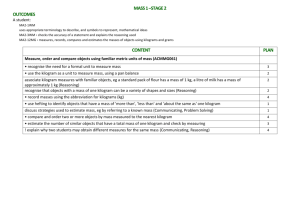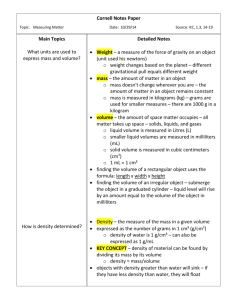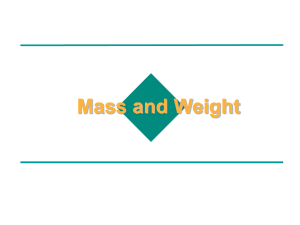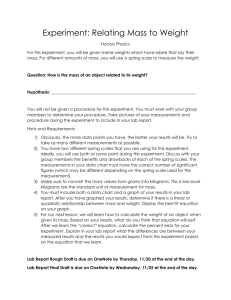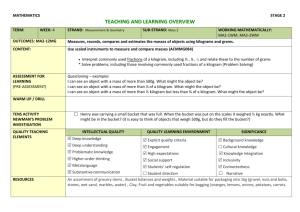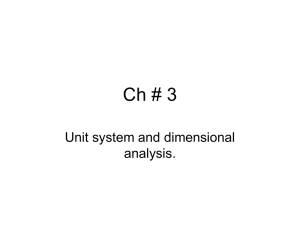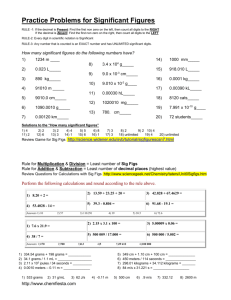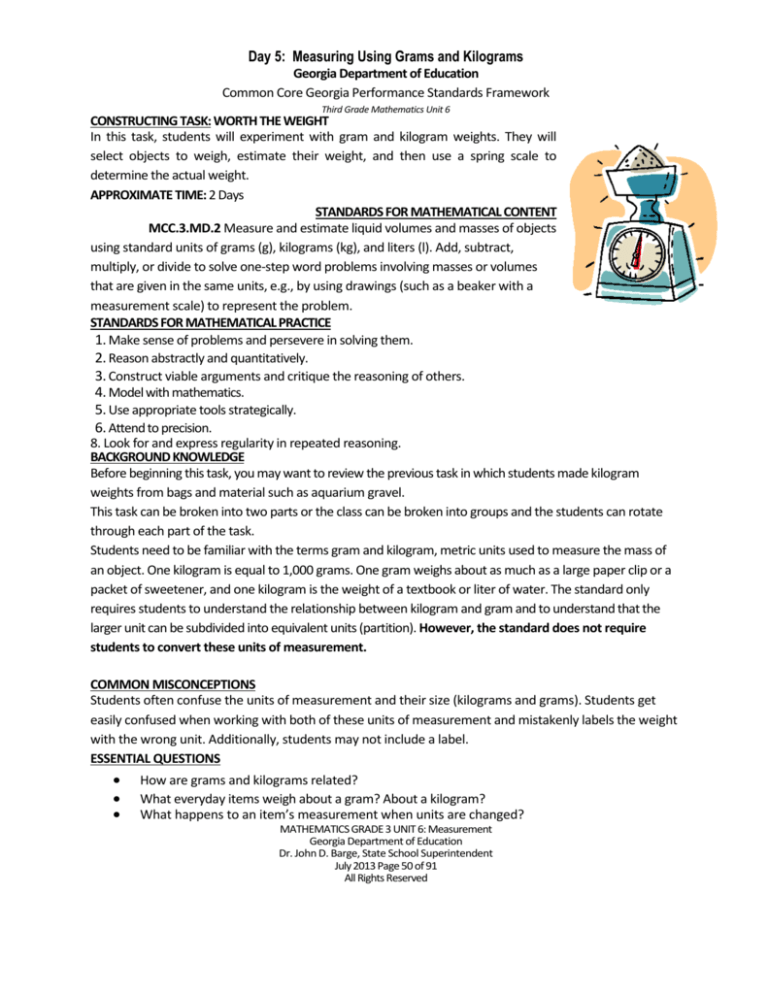
Day 5: Measuring Using Grams and Kilograms
Georgia Department of Education
Common Core Georgia Performance Standards Framework
Third Grade Mathematics Unit 6
CONSTRUCTING TASK: WORTH THE WEIGHT
In this task, students will experiment with gram and kilogram weights. They will
select objects to weigh, estimate their weight, and then use a spring scale to
determine the actual weight.
APPROXIMATE TIME: 2 Days
STANDARDS FOR MATHEMATICAL CONTENT
MCC.3.MD.2 Measure and estimate liquid volumes and masses of objects
using standard units of grams (g), kilograms (kg), and liters (l). Add, subtract,
multiply, or divide to solve one-step word problems involving masses or volumes
that are given in the same units, e.g., by using drawings (such as a beaker with a
measurement scale) to represent the problem.
STANDARDS FOR MATHEMATICAL PRACTICE
1. Make sense of problems and persevere in solving them.
2. Reason abstractly and quantitatively.
3. Construct viable arguments and critique the reasoning of others.
4. Model with mathematics.
5. Use appropriate tools strategically.
6. Attend to precision.
8. Look for and express regularity in repeated reasoning.
BACKGROUND KNOWLEDGE
Before beginning this task, you may want to review the previous task in which students made kilogram
weights from bags and material such as aquarium gravel.
This task can be broken into two parts or the class can be broken into groups and the students can rotate
through each part of the task.
Students need to be familiar with the terms gram and kilogram, metric units used to measure the mass of
an object. One kilogram is equal to 1,000 grams. One gram weighs about as much as a large paper clip or a
packet of sweetener, and one kilogram is the weight of a textbook or liter of water. The standard only
requires students to understand the relationship between kilogram and gram and to understand that the
larger unit can be subdivided into equivalent units (partition). However, the standard does not require
students to convert these units of measurement.
COMMON MISCONCEPTIONS
Students often confuse the units of measurement and their size (kilograms and grams). Students get
easily confused when working with both of these units of measurement and mistakenly labels the weight
with the wrong unit. Additionally, students may not include a label.
ESSENTIAL QUESTIONS
How are grams and kilograms related?
What everyday items weigh about a gram? About a kilogram?
What happens to an item’s measurement when units are changed?
MATHEMATICS GRADE 3 UNIT 6: Measurement
Georgia Department of Education
Dr. John D. Barge, State School Superintendent
July 2013 Page 50 of 91
All Rights Reserved
MATERIALS
“Worth the Weight, Part 1 – Grams” student recording sheet
“Worth the Weight, Part 2 – Kilograms” student recording sheet
Large paper clip
Gram weight
Balance
1 kg reference weights
Spring scales
Note:
One liter bottles filled with water weigh about one kilogram. Alternatively, fill bags with sand, aquarium
gravel, or dried beans. Students can use these “reference weights” to compare weights when looking for
items that weigh one kilogram.
GROUPING
Small Group Task
NUMBER TALKS
By now number talks should be incorporated into the daily math routine. Continue utilizing the different
strategies in number talks and revisiting them based on the needs of the students.
MATHEMATICS GRADE 3 UNIT 6: Measurement
Georgia Department of Education
Dr. John D. Barge, State School Superintendent
July 2013 Page 50 of 91
All Rights Reserved
TASK DESCRIPTION, DEVELOPMENT AND DISCUSSION (SMP 1, 2, 3, 4, 5, 6, and 8)
Part I
To introduce this part of the task, hold up a large paper clip and explain that it weighs about one gram.
Pass some large paper clips around to the students so that they can get an idea of how heavy a gram
feels. Involve the class in a discussion about what might be appropriate to measure in grams. After
asking the class for a few suggestions, students will list items in the classroom they think they could
weigh using grams. Ask students to record their items in the table on their student recording sheet,
“Worth the Weight, Part 1 – Grams.”
For each item on their chart, students should:
● hold the item to estimate its weight
● measure its weight using a spring scale
● write down the actual weight of each item
When students are finished, hold a class discussion about the following:
● what objects are appropriate to weigh in grams
● what students learned from this part of the task
Students will follow the directions below from the “Worth the Weight, Part 1 - Grams” student recording
sheet.
Think about how heavy a paper clip is. Now find five objects that you think should be
weighed using grams. Do not use a scale to check yet! After you have found five objects:
● Write the name of the objects in the chart below.
● Make an estimate for each item and record it in the chart below.
● Weigh each item using the scale provided and record it in the chart below.
1. How did you make your estimates?
2. Why are the items you chose appropriate to measure in grams? Be
ready to share your thinking with the class.
MATHEMATICS GRADE 3 UNIT 6: Measurement
Georgia Department of Education
Dr. John D. Barge, State School Superintendent
July 2013 Page 50 of 91
All Rights Reserved
Part II
To introduce this part of the task, pass the kilogram referents around to the students. Ask the class
for a few suggestions of classroom items for which kilograms would be an appropriate unit of measure.
For each item on their chart, students should first hold the item to estimate its weight (more than, less
than, or about 1 kilogram), measure its weight using a spring scale, and write down the actual weight
of each item.
When students are finished, hold a class discussion about what objects are appropriate to weigh in
grams and what students learned from this part of the task.
Students will follow the directions using “Worth the Weight, Part 2 - Kilograms” student recording
sheet.
FORMATIVE ASSESSMENT QUESTIONS
Why is it important to associate items with a weight?
Explain which unit of measure, gram or kilogram, would be best to use when measuring a student’s library book.
A student has a difficult time remembering the difference between gram and kilogram.
What would you do to help the student learn the difference between these two units?
DIFFERENTIATION
Extension
Have students find ten items around their house that they would measure using grams or
kilograms. Encourage them to find five items for grams, and five items for kilograms. Have
them estimate how much each item weighs.
Have students investigate what units are used to measure items too large to be recorded in
kilograms?
Have students estimate how many kilograms five different people weigh (family members,
neighbors, friends, babysitters, etc.).
Intervention
Each week, have a ten minute discussion about units of weights. Ask students to choose an
item from the classroom, discuss the appropriate unit to use to measure the weight, and
then estimate the weight of the object. In math journals, have students keep a reference list
of how much different items weigh using grams and kilograms. This can be used as a reference
throughout the year.
TECHNOLOGY CONNECTION http://gadoe.georgiastandards.org/mathframework.aspx?PageReq=MathHunt Is
a link to a classroom video of this task. Teachers may want to view this video to see how one teacher
implemented this task in his classroom.
MATHEMATICS GRADE 3 UNIT 6: Measurement
Georgia Department of Education
Dr. John D. Barge, State School Superintendent
July 2013 Page 50 of 91
All Rights Reserved
Name
Date
Worth the Weight
Part 1 - Grams
Think about how heavy a paper clip is. Find five objects you think should be weighed using
grams. Do not use a scale to check yet!
● Write the name of the objects on the chart below.
● Estimate each item’s weight and record estimation in the chart below.
● Weigh each item using the scale provided and record weight in the chart below.
Prediction
(check the correct box below)
Object
Actual Weight (g)
Less Than
More Than
About
1 gram
1 gram
1 gram
1.
2.
3.
4.
5.
6.
1. How did you make your estimates?
2. Explain why you believe the items you chose should be measured in grams but not
kilograms?
3. Choose one of your objects from the list above. Using only the actual weight, determine the weight of
five of those items WITHOUT using a scale. Explain how you did it using pictures, numbers, and
words.
MATHEMATICS GRADE 3 UNIT 6: Measurement
Georgia Department of Education
Dr. John D. Barge, State School Superintendent
July 2013 Page 50 of 91
All Rights Reserved
Name
Date
Worth the Weight
Part 2 - Kilograms
You and your partner are going on a kilogram scavenger hunt! Use one of the
reference weights to get an idea of how heavy one kilogram is. Then find items
around the room that weigh less than, about, and more than one kilogram.
1. List the items in the table below.
2. Predict whether each item is more than, less than, or about 1 kilogram.
3. Weigh each item with a spring scale.
4. Record the weight in the last column.
Remember: 1 kg = 1,000 grams
Object
Prediction
(check the correct box below)
Less Than
1 Kilogram
More Than
1 Kilogram
Actual Weight (kg)
About
1 Kilogram
7.
8.
9.
10.
11.
12.
1. Look at the table. Write what you found about your understanding of a kilogram? Be prepared to discuss your
findings with the class.
2. Choose one of your objects from the list above. Using only the actual weight, determine the weight of
twelve of those items WITHOUT using a scale. Explain how you did it using pictures, numbers, and words.
3. On the back of this sheet, list at least five items for which kilograms would be appropriate as the unit
of measure.
MATHEMATICS GRADE 3 UNIT 6: Measurement
Georgia Department of Education
Dr. John D. Barge, State School Superintendent
July 2013 Page 50 of 91
All Rights Reserved


